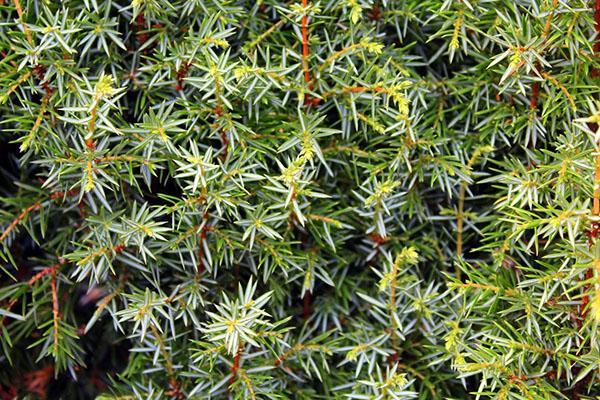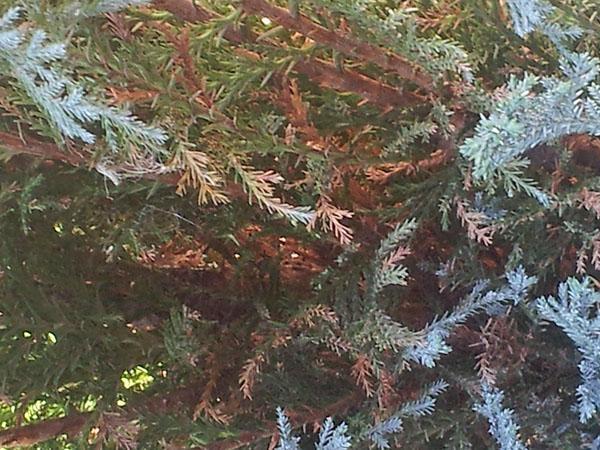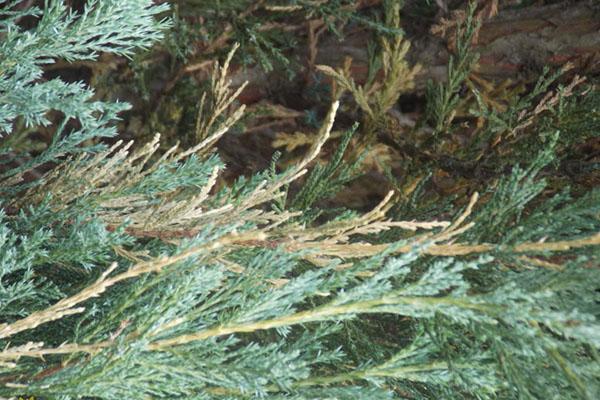Juniper diseases and their treatment with effective drugs
 Not everyone knows what juniper diseases are and their treatment. But in order to achieve the desired result, and return the plant to an attractive appearance, it is necessary to learn how to recognize diseases and take action at the first symptoms.
Not everyone knows what juniper diseases are and their treatment. But in order to achieve the desired result, and return the plant to an attractive appearance, it is necessary to learn how to recognize diseases and take action at the first symptoms.
Common juniper diseases and their treatment
Growing conifers in a summer cottage, you need to be able to provide the necessary assistance when problems are detected.
Fusarium juniper

Young twigs are most affected by Fusarium.
The infection persists for a long period of time. Its main place of residence is the soil and the affected stems.
A favorable environment for Fusarium are:
- loamy soil;
- excess moisture;
- lack of light.
To get rid of this problem, it is necessary to carry out culling in a timely manner. Also, at the first symptoms of the disease, it is recommended to remove the affected plants along with the root system.
As a preventive measure, young plants are treated with Bactofit before planting. They also use a drug called Vitarox. When the first signs of the disease appear, the soil around the plant should be watered with Fitosporin solution. Plants are also treated with Fundazol.
Drying of shoots
 The causative agents are some types of fungi. When they appear, the bark begins to dry out. Brown growths appear on its surface, the branches turn yellow, and the needles crumble. The infection that leads to this problem is stored in the affected bark, branches and uncleaned shoot debris.
The causative agents are some types of fungi. When they appear, the bark begins to dry out. Brown growths appear on its surface, the branches turn yellow, and the needles crumble. The infection that leads to this problem is stored in the affected bark, branches and uncleaned shoot debris.
In order to prevent such a problem, it is necessary to use only high-quality planting material. It is also recommended to carry out correct and timely pruning of shoots. In order to prevent the development of infection, all affected areas and sections should be treated with 1% solution of copper sulfateand apply a layer of oil paint on top.
In early spring and late autumn, juniper is sprayed with Bordeaux mixture. If the disease is started, then the procedure is repeated.
Juniper Alternaria
 A sign of the disease is brown needles and a pronounced dark bloom on the shoots. If the disease is not treated with anything, then over time, the branches will begin to fade. The cause of the appearance of Alternaria is the thickening of the plantings.
A sign of the disease is brown needles and a pronounced dark bloom on the shoots. If the disease is not treated with anything, then over time, the branches will begin to fade. The cause of the appearance of Alternaria is the thickening of the plantings.
Alternaria appears only on the lower branches.
Infection persists in the affected areas and uncleaned leaves. They fight Alternaria in the same way as with the wilting of shoots.
Shute juniper
 This disease has another name - brown gray mold. Its causative agents are fungi that begin to infect shoots at a temperature of +0.5 aboutFROM.
This disease has another name - brown gray mold. Its causative agents are fungi that begin to infect shoots at a temperature of +0.5 aboutFROM.
Schütte infects plants only under snow.
The symptoms of the disease are twigs that have a brown or yellowish tint. The needles also change color and are glued together using a grayish spider web.
With the shute, despite the fact that the needles acquire a reddish tint, they do not crumble. But thin twigs dry out pretty quickly. It is they who, first of all, are affected by this disease.
This problem is often caused by high soil moisture, as well as thickening of plantings. Prevent development shute can be timely pruning dry shoots. It is also recommended to spray the plant with Bordeaux mixture twice a year.
Juniper rust
 This is the most common juniper disease. Mushrooms that lead to this problem sprout on needles, twigs, cones. Such growths have thickening and a bright shade. Bulges and sagging appear on the trunk or at the root collar. Because of them, the bark dries out, and shallow wounds form on the surface.
This is the most common juniper disease. Mushrooms that lead to this problem sprout on needles, twigs, cones. Such growths have thickening and a bright shade. Bulges and sagging appear on the trunk or at the root collar. Because of them, the bark dries out, and shallow wounds form on the surface.
In early spring, when the snow has not yet melted, growths of a dark brown hue are formed. They are often called teliozha. After rain or heavy fog, they become soft and swell, covered with mucus on top. It is in them that spores are formed that are able to germinate and be carried by the wind.
If you do not take action, the branches dry out rather quickly, the needles change their color to brown and crumble. Infection hibernates on the bark. It can also attack quince and apple trees. Fight rust by removing affected branches. Periodic spraying with Bordeaux mixture is also recommended.
Bark necrosis
 You can identify the disease by the presence of so-called pads, which have a brick-red hue. Growths grow up to 2 mm wide. After a few days, they begin to darken and dry out. Bark necrosis can also affect the root system. The roots are affected and dry out over time. A similar thing is observed with twigs and needles. The infection persists in diseased branches, plant debris. They fight necrosis as well as wilting branches.
You can identify the disease by the presence of so-called pads, which have a brick-red hue. Growths grow up to 2 mm wide. After a few days, they begin to darken and dry out. Bark necrosis can also affect the root system. The roots are affected and dry out over time. A similar thing is observed with twigs and needles. The infection persists in diseased branches, plant debris. They fight necrosis as well as wilting branches.
Biotorella cancer
 The causative agent of this disease is the biatorella diformik mushroom.
The causative agent of this disease is the biatorella diformik mushroom.
Signs of the disease:
- Drying of branches.
- Bark cracking and sores in the wood.
- The wood becomes brown and starts to rot.
Pathogenic microorganisms appear in places where the bark has cracked or received mechanical damage. The fungus develops in the tissues, after which the bark becomes brown and dries up after a while. Such lesions lead to the fact that the needles and twigs begin to turn yellow and dry.
In order to prevent such a problem, it is necessary to follow all the rules and recommendations of agricultural technology. It is also recommended to use high-quality seedlings, because they are the ones who carry such an infection.
But, if, nevertheless, signs of a disease appear on the plant, it is necessary to remove the affected shoots as soon as possible. Spray all sections and deformed areas with a weak solution of copper sulfate. Cover the processed twigs and trunk with paint or drying oil. In the first month of spring and in October, it is recommended to carry out prophylaxis with Bordeaux mixture. Hom or Abiga-peak can be used instead of this drug.
Juniper pests
Natural disasters contribute to the appearance in the garden of a large number of various insects that damage plants.
Angle-winged moth
 It is a butterfly that has a purple-gray hue. Its wingspan is within 30 mm. There is a small notch on their outer edge. There are three lines on the front wings, and two lines on the back ones.
It is a butterfly that has a purple-gray hue. Its wingspan is within 30 mm. There is a small notch on their outer edge. There are three lines on the front wings, and two lines on the back ones.
The tracks are up to 30 mm long. They are green with a brownish head. There are dark green stripes on the surface. Caterpillars grow up to 30 cm long. The pupa is brown. Its length is about 11 mm. They hibernate in soil or in dry grass.
Caterpillars and butterflies feed on needles and juniper twigs. Fighting the angle-winged moth is not difficult. To do this, annually in May, it is necessary to spray the plant with Fufanon, Aktellikom or Decis Profi. If the branches are badly damaged, then all dry shoots are cut and removed, as far as possible from the place where the juniper grows.
Juniper Scale
 This is an insect that is small in size. The female is elongated. It reaches 2 mm in length and is brown in color.The larvae appear in the first part of June.
This is an insect that is small in size. The female is elongated. It reaches 2 mm in length and is brown in color.The larvae appear in the first part of June.
Juniper scale insects feed on needles and cones. It also affects pines, thuja and cypress.
In the case when the plant is severely damaged, the needles turn brown and the branches begin to dry. If you do nothing, then the plant will dry out in a fairly short time. You can fight this pest with the help of actellik, fufanon.
When properly planted and cared for, junipers will always have a healthy appearance. But if, nevertheless, the plant begins to wither and lose its needles, then simple measures will help get rid of diseases.